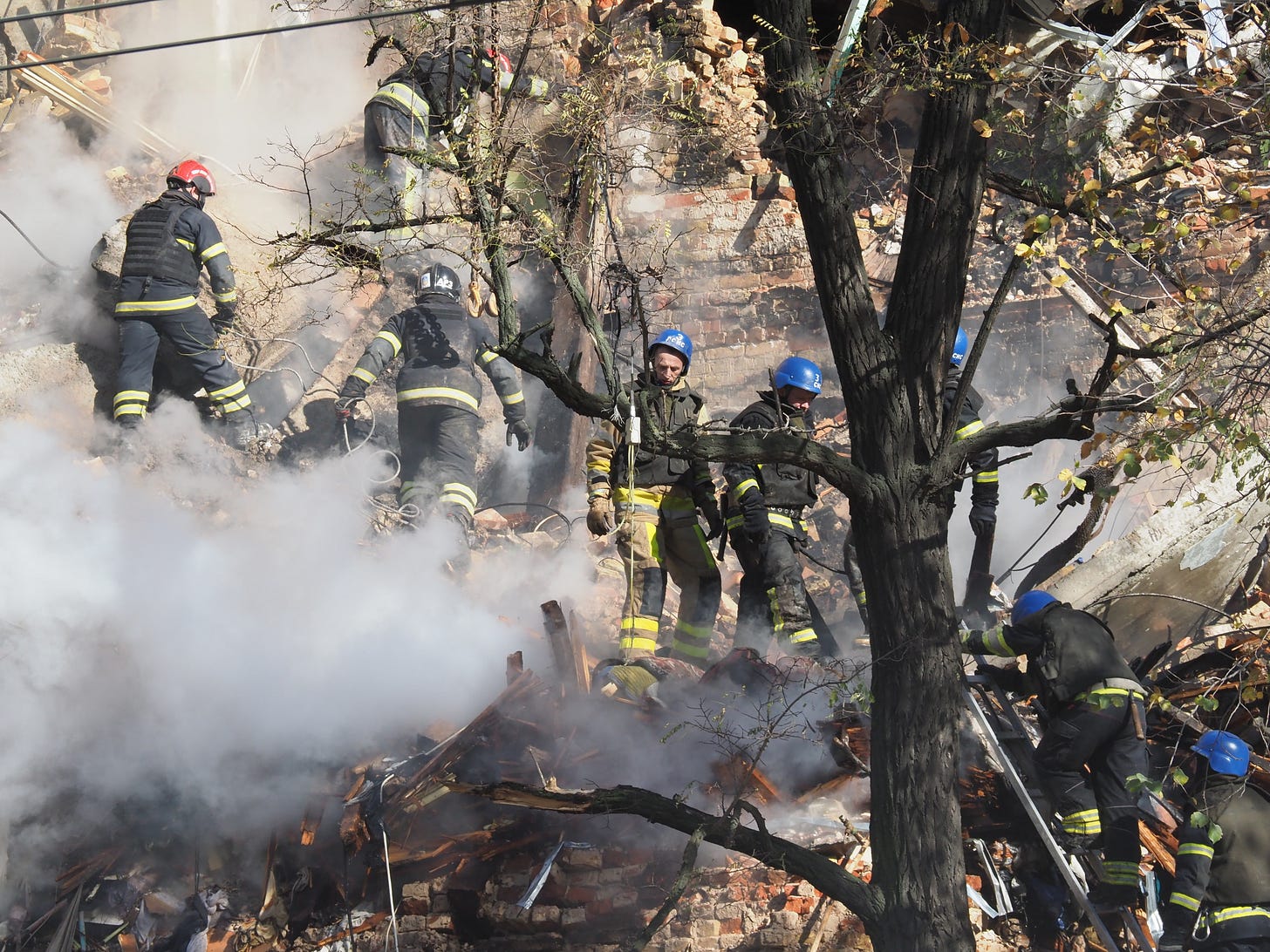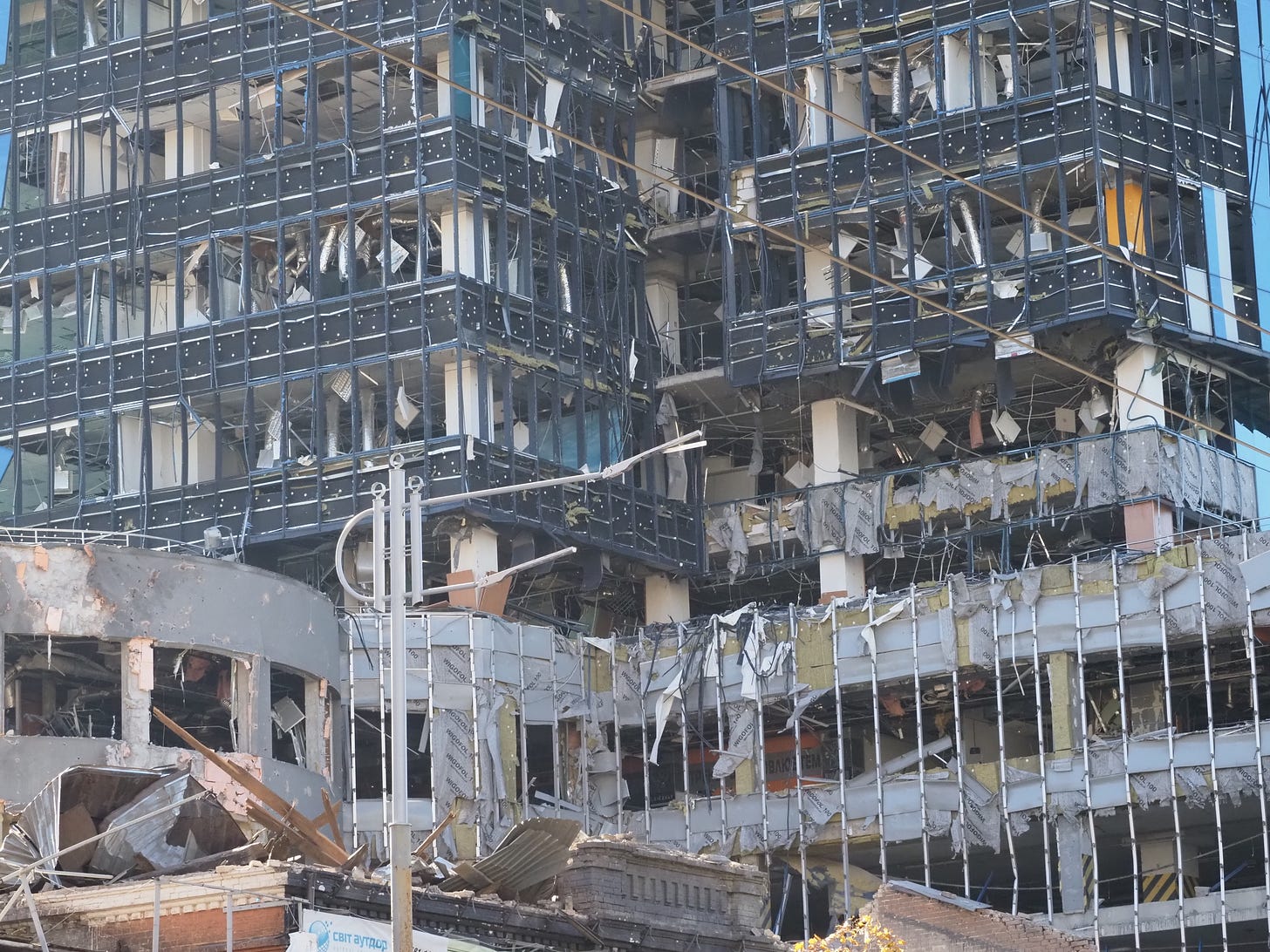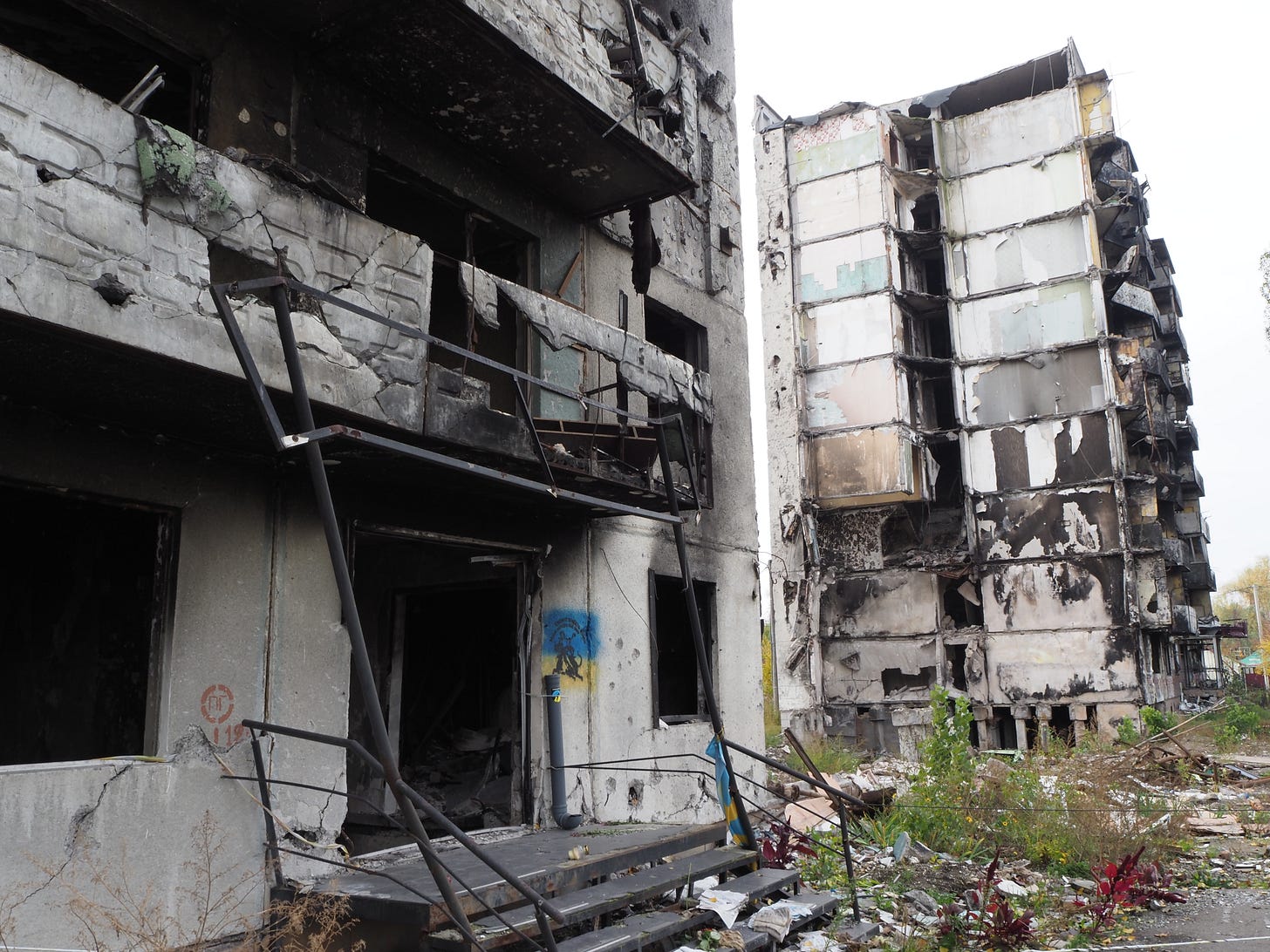Reflections: Ukraine's October Surprise and Winter of Grit
Part One: As the first anniversary of war recedes, a look back at Ukraine's most difficult winter, marked by missiles, darkness, and cold
It was a foggy Monday morning like any other in Khmelnytskyi – until there was the sound like a fully-loaded 16-wheel truck crashing 100 miles per hour into a steel reinforced concrete wall. Then it happened again, but louder. Quickly to my laptop, the news was saying the capital – 170 miles east of here – was already under missile attack. Then the headlines stopped coming in, as another missile struck Khmelnytskyi, knocking out the electricity instantly. A new phase of the war had just begun. Missiles struck every major city in the nation that day, killing at least 23 people, and tipping off a nation-wide spiral of blackouts that persists to this day.
October 10 is a date whose infamy is only surpassed by the first day of the war itself. At no time since the first week of the war had there been nation-wide missile strikes at that scale. Of course, the war raged violently in the east and the south all summer. Yet the central and western parts of the nation were blessed with relative peace. Many in Kyiv described it as “almost back to normal” – the city where early in the war Russian invaders were repelled from a Stalingrad-style encirclement attempt. But the autumn missile campaigns evaporated any pretense of that summertime optimism, when Kyiv again found itself the center of tragedy.
As winter ebbs, and rumors flow – as the nation braces itself for what new assault the spring awaits – let us reflect on this strange and barbaric year of war. Not just a single year of lost time, but a retrogression threatening 31 years of post-Soviet development. A war for the very identity of a people, yet with no end in sight …
- -
Just days before that strike, the entire nation erupted in celebration at the mysterious bombing of the Kerch Strait Bridge, which connects occupied Crimea to mainland Russia. The bridge is one of Russia’s most potent symbols of dominion over Ukraine. It is an engineering feat which Nazis and Soviets both tried and failed to achieve, before Putin’s Russia finally pulled it off in 2018. At a cost of a quarter trillion rubles, it became the longest bridge in Europe, just four years after Russia annexed Crimea. But besides its patriotic significance, it was Russia’s most important military supply line to Ukraine’s occupied south. When the spectacular footage of its partial destruction emerged early Saturday morning – one day after Putin’s birthday – it was in the back of every mind what Russia might do next.
By that Monday’s mass attack, Ukraine had its answer. By Tuesday, with Khmelnytskyi still without electricity, the jubilee became a dirge. Masses of people gravitated to the city center in search of power. ATM machines were out of order. Information was scarce. The only place with electricity was a small shopping mall that had a backup diesel generator. People scoured the mall for power outlets like bees on honey. Lines formed down the street for the only two coffee kiosks open and serving. It felt like the first day of war all over again.
In just that one day of attack, the local press reported that an entire third of the country’s electric infrastructure was “damaged.” As a rule of thumb, that would mean the real number was actually higher. But regardless of how it’s quantified, the destruction was easy to measure by the new regime of daily rolling blackouts. To compensate for the floundering electric grid, power schedules became the norm. Power would be distributed to different districts at different times per day. In practice, the published schedules were hardly relevant, with most places receiving less than 12 hours of light on a good day – as few as four hours on a bad one.
From that moment, daily life took on strange dimensions. Life under martial law in Kyiv teetered on a spectrum form weird to fatal. The energy challenges meant that the work-from-home era was finished. Cafés and restaurants with Wi-Fi became the de facto offices of wartime. “How to work when there is no electricity?” asked Taras, a 32-year-old software developer, “people flocked to coffee places to do their work – all tables occupied by people with laptops, all people are sleepy.”
Then there was the multiple-times daily slow and haunting wail of the air alarms. They can happen at any time, even in the middle of the night, and last anywhere from ten minutes to hours.
“Air alarms make you feel worry all the time, especially when it’s five times per day,” said Dana, 30. But most Ukrainians carry out their days unfazed – perhaps uttering suka blyat. “The nature of air alarms changes very quickly, you get used to it and just think, ‘again, these fucking Russian missiles.’”
“Frankly, not all shelters are safe enough. I’ve been to the shelter only once,” said Taras. “When I hear an air alarm and in case I feel anxiety, I just sit at my piano and play the Ukrainian national anthem.”
Though most air alarms don’t materialize into actual air attacks, they always bring chaos. Most stores will close for business during an air alarm. One afternoon in the popular Globus mall food court, a loudspeaker suddenly announced that the mall was closed. Security guards whisked away diners – amid the flutter of bodies, half eaten lunches and unfinished cappuccinos were left behind on every table.
The very next Monday, October 17, the sun had not yet risen when the air raid sirens blared at 6:30 in the morning. A common phenomenon. But this air alarm was different – within five minutes the bomb blasts shook you out of bed. From my hotel room window, I saw the black plume of smoke rising from where a “kamikaze drone” had just destroyed a residential building – killing five people, including a six-months pregnant mother-to-be, her husband, and their cat. As I ran about the hotel room collecting a bag, that unworldly sound of obliterating stone became more defined with each new hit.
“I felt how the building was shaking, I ran immediately in my pajamas with laptop to the shelter,” said Dana, an employee of the bank. “I was on the fourteenth floor, and the elevator was not working, so while I was running down the stairs, I heard more explosions. My body started to tense up – I didn’t want to die there.”
The pile of stone was still on fire, six hours after the collapse of the hundred-year-old four-story apartment building that killed the pregnant woman. With smoke rising from beneath the rubble, a crew of heroic fire fighters climbed over the wreck like a column of ants on a monolith. They dug in the smoldering debris with their hands, a crane, and a cherry picker. By miracle, 19 people were pulled from the remains alive. The street was littered all over with pulverized brick and broken glass. Across the road was the hulk of a deserted office tower, used before the war by the German consulate, now with most of its façade peeled off like flesh from a skull.
“I remember exactly that moment,” said Dana, “it was beautiful outside, it was sunny and the sky was so blue – and you’re watching the totally destroyed building in that very same time. It was like an evil came to your land.” As she recalled the event, her head began to hurt. “She was pregnant with baby. She had the chance to live a happy life with child, have a family, but because of these terrible Russian missiles …” She struggled to complete her sentence.
It was the first time the Iranian-made Shahed drones were unleashed upon Kyiv. The air defenses were completely unprepared. As drones approached their targets, police officers on the ground frantically fired their Kalashnikovs in the air in a futile attempt to avert disaster. Drones and missiles also hit infrastructural targets all over the nation that day, compounding the energy crisis such that the official linguistics changed from one third “damaged” to “destroyed.” With the temperatures dropping and the sun setting earlier each day, the novel inconveniences of October would soon become the existential extremes of November.
“Each morning we had an air alarm, my first reaction was, ‘I need to wake up quickly and have a shower as soon as possible,’” said Taras, “because in case they’ll hit critical infrastructure, I’ll have no water again.”
When a power grid fails, it’s not simply electricity that disappears. With each new blow, there are tack-on effects. For instance, unlike the Romans who built a water distribution grid powered by gravity, most modern nations’ water supplies depend on electric pumps. (Including the United States.) When there is an unplanned power outage – such as one caused by a missile physically destroying the local transformer stations – that usually means there is no running water either. (That means you can’t flush your toilet.) Centralized heating, which is common in Ukraine, fails. The communication networks collapse, as cell towers and internet switches go offline, lowering capacity while increasing demand. Modern life is a house of cards waiting to blow away.
The effect, said Natalia, a 53-year-old accountant, was like “our civilization rolling back in time. Ukraine was in the stone age.” She said, “life stops and seems to freeze. Everything shrinks and becomes more narrow.”
By mid-November it already started to snow – every day. When it is below freezing outside; when there is no electricity, no heat, no water; when your hot water tank won’t start; when you’re sitting in candle light under layers of blankets, under your uninsulated roof, waiting for the sun to rise for your next joule of heat – it’s a type of existence long forgotten by developed civilizations. It is a condition for which there is no nostalgia.
In Khmelnytskyi, Natalia’s hot water tank needed to be repaired five times in the month of December – first it’s circuits fried, then its pumps broke, then it filled with sludge – multiple times. With the water supply stagnating under reduced pressure, sediment came up through the faucets. With the sewage system under-powered to evacuate discharge … we hoped it was just sediment turning the water brown.
“It was sub-zero temperature outside,” said Natalia, “I was under three layers of blankets, wearing a hat indoors … I know many people who have burnt out refrigerators, televisions, microwaves, due to the voltage surges.”
The breakdown of information streams also posed an anachronism. People with families living in the villages often had no way of contacting them after a missile strike. People in the villages had no way of knowing even what was happening with the war. “My parents in Irpin, they used to have several days in a row without electricity,” said Taras. “You have no internet and even no way to call your close ones. I remember days when I was able to reach out to my parents and they were asking me questions, like ‘what’s happening in the news?’”
Earlier in the war, Irpin was the site of a devastating one-month battle. Just north of Kyiv, it was awarded “Hero City of Ukraine” for the price it paid halting the Russian army at the capital’s gate. It’s critical infrastructure was a shambles even months before the mass missile attacks began. Further north, past the city of Bucha, practically no building in the town of Borodyanka even had windows any more.
It was some of the darkest days, of the war, and our lives. But the human spirit in Ukraine was indomitable. Ukraine had not yet perished.
Stay tuned for Part Two, coming next week
Photos: Maidan Nezalezhnosti - “Independence Square” - at dawn; Heroes searching for survivors of the Oct. 17 drone strike in Kyiv; The heavily damaged office tower once serving the German consulate; “Car Graveyard of Irpin”; A destroyed apartment block in Borodyanka. All photographs by John Bolger





